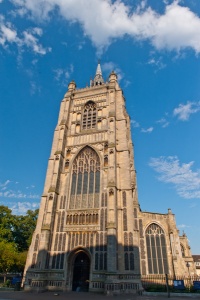
When the followers of William the Conqueror settled in Norwich they built a formidable fortress atop a high mound, or motte. Just outside the castle bailey enclosure they established a market, and invited Norman settlers to populate an area near the market known as the 'French Quarter'. To service the French Quarter the Normans founded three churches, among them St Peter Mancroft, on the edge of the market.
What's in a name?
Who is St Peter Mancroft? The answer is 'no one', for there is no such saint. The word 'Mancroft' may be a mangling of the Old English gemaene croft, meaning a common field. another possibility is that it recalls a previous owner of the land named Manne. Or possibly it comes the Latin 'magna crofta', for 'great field'. No one knows for sure.
St Peters is by far the largest of the 3 churches (the others being St Giles on the Hill and St Stephen). It is among the largest and most impressive parish churches in England, a fact underlined by its membership in the Greater Churches Network, an association of over 30 non-cathedral English churches of outstanding historical and architectural importance.
History
It was probably founded by Ralph de Guader, the new Earl of Norfolk, around 1075. Ralph gave the church to his chaplain Wala, shortly before he launched an unsuccessful rebellion against William the Conqueror. Wala fled to Gloucester after his patron's rebellion, and granted the church to St Peter's Abbey there. For the next 3 centuries St Peter Mancroft was called St Peter of Gloucester in Norwich.
In 1388 it was passed to the Benedictine monastery of St Mary in the Fields (see Assembly House). The Benedictines decided to rebuild St Peter's, but it was not until 1430 that construction began, aided by donations from wealthy parishioners. It took 25 years to complete the rebuilding, but the result is a church that is almost entirely mid-15th century in style, with a Perpendicular style blessedly unaltered by subsequent rebuilding.
It is because construction was so concentrated into a short period of time (by parish church standards) that St Peter's is such a delight; a wonderful example of 15th century architecture.
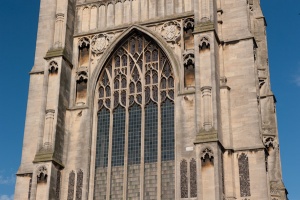
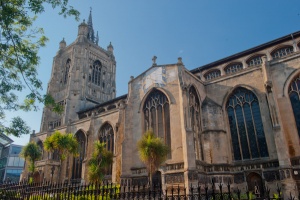
When the monastery of St Mary in the Fields was suppressed by Henry VIII the church passed through private hands until it was purchased by the parish itself in 1581. The importance of the church in the history of Norwich is reflected in the very large number of memorials to Mayors, Sheriffs, and successful merchants.
The exterior is almost entirely faced in limestone, a testament to the wealth of the parish, for there is no stone available locally, and building materials had to be imported by sea and then carted overland. There are very large porches on both north and south sides, with a parvise, or small first-floor chamber over the north porch.
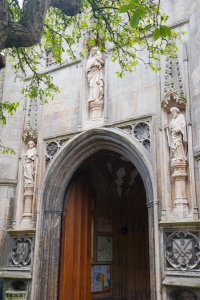
The interior is lit by a clerestory running the full 60-foot length of the nave. The sense of space and light is emphasised because there is no division between the nave and chancel. The only real indication that you are passing into the chancel is that the timber roof there has decorated bosses of gilded angels and suns. The hammer-beam roof is simply glorious, a wonderful testament to the craft of medieval woodworkers.
THE NAVE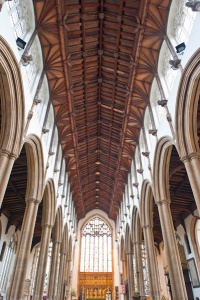
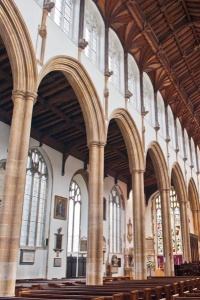
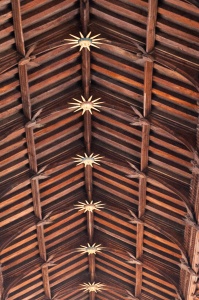
The east window has a wonderful collection of 15th century stained glass by the Norwich School of glass painters. The glass was gathered into this one window after an explosion in 1648 destroyed windows around the church.
The explosion occurred when rioters tried to break into a weapons store on Bethel Street but unintentionally set off a store of gunpowder (see more of the story in our article on St Stephen's church).
The resulting explosion caused damage to churches for several miles around, and destroyed much of the original medieval glass in St Peters. The glass is displayed in 42 panels, surrounding a set of 7 central panels made in 1888.
EAST WINDOW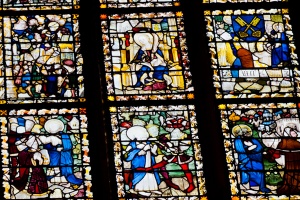
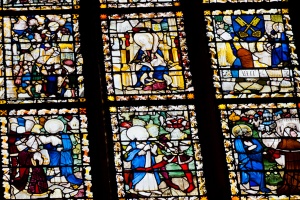
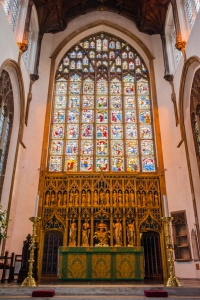
Behind the altar is a reredos designed by JP Seddon in 1885 and gilded by Sir Ninian Comper in 1930. Though the choir stalls are mostly Victorian, they do contain medieval two seats with misericords.
In the baptistry is a tapestry woven in 1573 by Flemish refugees who settled in Norwich, depicting the Biblical Resurrection of Christ.
THE MANCROFT TAPESTRY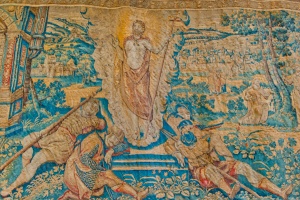
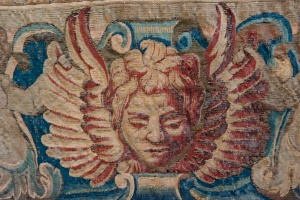
Nearby is a medieval font under a rare 15th century brightly painted wooden canopy. Though the base of the canopy is original, the top section was rebuilt in the Victorian period. It is similar to the ornate (and fully original) canopy at Trunch, also in Norwich.
FONT and CANOPY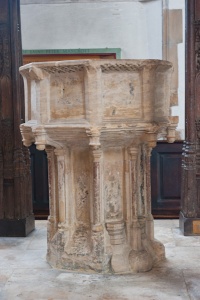
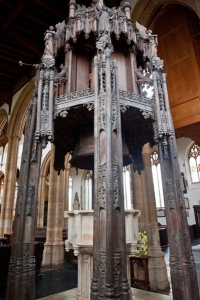
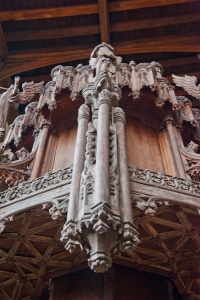
One of the oldest parts of the church is the sacristy, outside the east end. This was once used as a treasury store, and later as accommodation for priests.
MONUMENTS
There are a wealth of monuments inside the church. One of the best is to Thomas Browne (1605 - 1682), set on the south wall of the sanctuary Browne was the author of Religio Medici and other works on medicine. He was knighted by Charles II, though in rather a bizarre way.
The king came to Norwich in 1671, intending to knight the mayor. The mayor, however, refused the honour. Browne was proposed as a replacement, and the king duly knighted him.
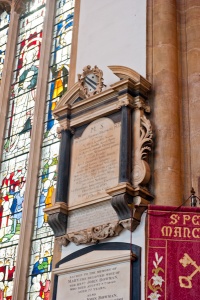
An even earlier tomb is that of Francis Wyndham (d.1592), a lawyer and magistrate who worked on several high-profile treason trials, and advised on the trial of Mary, Queen of Scots. This is the largest memorial in the church and shows a 'half-figure' of Wyndham wearing his judge's robes, beneath an oversized frame. Interestingly, though there are heraldic shields on the tomb base, none bear any insignia, and there is no text on the tomb.
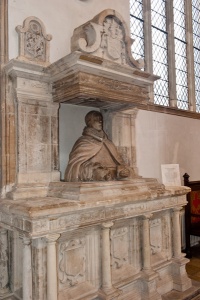
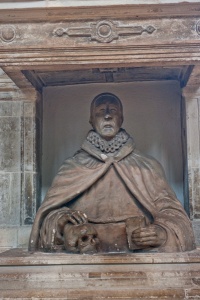
Another interesting memorial is to Sir John Harrison Yallop (1762-1835) a goldsmith and Mayor of Norwich who made his fortune by winning a Government Lottery.
The Boy Bishop
The north transept holds a reminder of a fascinating medieval custom. Before the Reformation put an end to such practices an election was held in the transept each year to elect a 'Boy Bishop'. The 'bishop' and his deacon assistants had mock clerical robes and mitres. A special coin was minted to commemorate each bishop. One such coin can be viewed in the Castle Museum.
Perhaps the last word should go to John Wesley, who wrote in his diary that the sides of the church seemed almost all window, making the interior surprisingly cheerful. Wesley concluded that he had seldom seen a more beautiful parish church. Indeed.
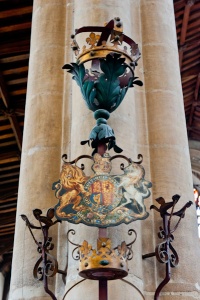
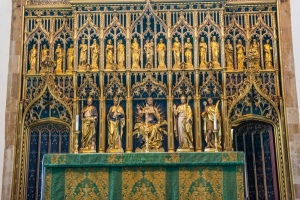
About St Peter Mancroft
Address: Market Place,
Norwich,
Norfolk,
England, NR2 1RD
Attraction Type: Historic Church
Location: Immediately beside the Forum, on the south side of the market place. Five-minutes walk from the castle car parks. Open daily except Sunday to visitors.
Website: St Peter Mancroft
Email: secretary@stpetermancroft.org.uk
Location
map
OS: TG229084
Photo Credit: David Ross and Britain Express
HERITAGE
 We've 'tagged' this attraction information to help you find related historic attractions and learn more about major time periods mentioned.
We've 'tagged' this attraction information to help you find related historic attractions and learn more about major time periods mentioned.
Find other attractions tagged with:
NEARBY HISTORIC ATTRACTIONS
Heritage Rated from 1- 5 (low to exceptional) on historic interest
Norwich Guildhall - 0.1 miles (Historic Building) ![]()
Norwich, St Stephen's Church - 0.1 miles (Historic Church) ![]()
The Assembly House - 0.1 miles (Historic Building) ![]()
Norwich Castle - 0.2 miles (Castle) ![]()
Norwich, St John Maddermarket Church - 0.2 miles (Historic Church) ![]()
Bridewell Museum - 0.2 miles (Museum) ![]()
Strangers Hall - 0.2 miles (Museum) ![]()
Norwich, All Saints Westlegate - 0.2 miles (Historic Church) ![]()



